Click on images to enlarge
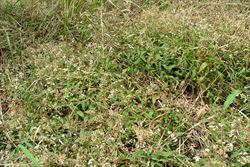
infestation (Photo: Sheldon Navie)
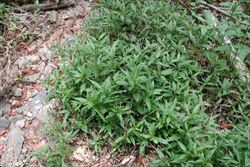
habit prior to flowering (Photo: Sheldon Navie)

habit in flower (Photo: Sheldon Navie)
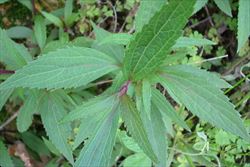
elongated and paired leaves (Photo: Sheldon Navie)

close-up of leaf (Photo: Sheldon Navie)
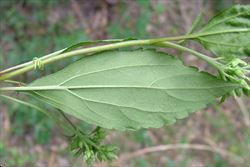
young stem and underside of leaf (Photo: Sheldon Navie)
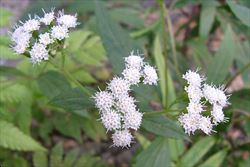
flower clusters (Photo: Sheldon Navie)
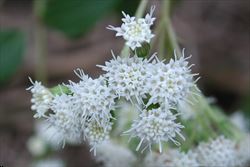
close-up of flower-heads, each with several tiny tubular flowers (Photo: Sheldon Navie)
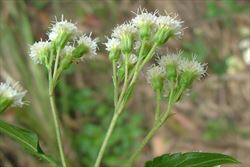
close-up of flower-heads showing the greenish bracts (Photo: Sheldon Navie)
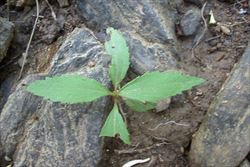
seedling (Photo: Sheldon Navie)
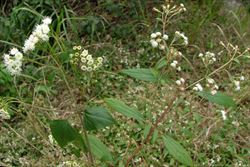
comparison of crofton weed (Ageratina adenophora), left, and mistflower (Ageratina riparia), right (Photo: Sheldon Navie)
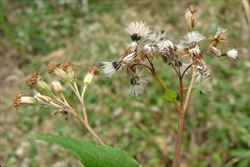
old flower-heads and seeds (Photo: Sheldon Navie)
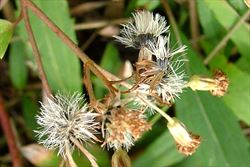
seeds (Photo: Sheldon Navie)
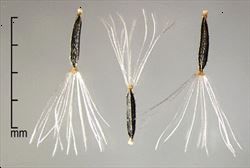
close-up of seeds (Photo: Julia Scher)
Scientific Name
Ageratina riparia (Regel) R.M. King & H. Rob.
Synonyms
Eupatorium cannabinum L. (misapplied)Eupatorium riparium Regel
Family
Asteraceae (Queensland, New South Wales, the ACT, Victoria, Tasmania, Western Australia and the Northern Territory)Compositae (South Australia)
Common Names
cat's paw, catspaw, creeping crofton weed, creeping croftonweed, mist flower, mistflower, mistweed, river eupatorium, small crofton weed, white weed, William Taylor
Origin
Native to Mexico and the Caribbean.
Naturalised Distribution
Widely naturalised in eastern Australia (i.e. in the coastal districts of New South Wales and eastern Queensland). It is most abundant in the forested coastal regions near the Queensland/New South Wales border, but is also relatively common in the coastal areas of central New South Wales. It has also been recorded in central and northern Queensland and as far south as Nowra on the New South Wales south coast. Also naturalised on Norfolk Island and possibly sparingly naturalised in south-western Western Australia.
Widely naturalised in other parts of the world, including southern Africa, Madagascar, tropical Asia, New Zealand, the Canary Islands, La Réunion and Hawaii.
Habitat
Mistflower (Ageratina riparia) is generally found growing in wetter (i.e. humid) sub-tropical and tropical regions. Within such regions it is a weed of damp areas such as gullies, creek banks, waterways, roadsides, disturbed sites, pastures, native bushland, rainforest clearings and the margins of closed forests.
Habit
A long-lived (i.e. perennial) spreading herbaceous plant or low-growing shrub. It usually only grows 40-60 cm tall, but can occasionally reach up to 1 m in height.
Distinguishing Features
- a long-lived scrambling herbaceous plant with numerous spreading stems.
- its oppositely arranged leaves are relatively narrow with toothed margins.
- its numerous small white flower-heads are clustered together at the tips of the branches.
- its small blackish-brown seeds (1-2 mm long) are topped with a ring of whitish coloured hairs (3-4 mm long).
Stems and Leaves
The numerous stems are relatively weak and the lower branches readily produce roots at their joints (i.e. nodes) if they come into contact with the soil. Branches tend to grow obliquely at first, then upwards (i.e. they are decumbent or ascending). These stems are often reddish or purplish in colour and have a sparse covering of fine hairs (i.e. they are sparsely pubescent).
The leaves are oppositely arranged along the stems and borne on short stalks (i.e. petioles) 5-15 mm long. They are relatively narrow (i.e. narrowly-ovate or lanceolate) and prominently veined. These leaves (3-11 cm long and 8-30 mm wide) are mostly hairless (i.e. glabrous) and taper to a point at their tips (i.e. they have acute apices). Their margins are sharply toothed (i.e. serrated), especially toward their tips.
Flowers and Fruit
The small white flower-heads (i.e. capitula) do not have any obvious 'petals' (i.e. ray florets) and consist of several tiny flowers (i.e. tubular florets) surrounded by two rows of greenish bracts (i.e. an involucre) about 4-5 mm long. The tiny tubular florets are white in colour and also about 5 mm long. Several of these flower-heads are clustered together at the tips of the branches (i.e. into terminal corymbose inflorescences). Flowering occurs from late winter through to late spring, but is most abundant during mid-spring.
The small 'seeds' (i.e. achenes) are slender, blackish-brown in colour and slightly curved. These 'seeds' (1-2 mm long) have four or five hairy ridges which run lengthwise (i.e. longitudinally) and they are topped with a ring (i.e. pappus) of several larger whitish coloured hairs (3-4 mm long).
Reproduction and Dispersal
This species reproduces by seeds, which are easily dispersed by wind and readily float on water. They may also become attached to animals, clothing, vehicles or machinery and can be spread in contaminated agricultural produce.
Environmental Impact
Mistflower (Ageratina riparia) is a significant environmental weed in New South Wales and Queensland. It is also currently listed as a priority environmental weed in at least one Natural Resource Management region in Australia. This species can quickly invade disturbed bushland on frost-free slopes and rainforest gaps, displacing the native vegetation. However, it is especially invasive in gullies and riparian habitats and is often reported to dominate the groundcover vegetation along waterways. It is shade tolerant and can almost totally exclude native plants in these areas, an may even displace many of the animals which were reliant upon those plants.
Mistflower (Ageratina riparia) is a very aggressive weed in south-eastern Queensland, and is listed among the top 25 most invasive weed species in this region. It prefers wetter habitats in coastal districts, and is most prominent in areas such as the Gold Coast hinterland region. For example, mistflower (Ageratina riparia) is listed as one of the environmental weeds that are currently threatening the integrity of the Burleigh Heads National Park, just north of the New South Wales border. Because mistflower (Ageratina riparia) is highly invasive along wet forest streams, it is also thought to have a negative impact on the habitats occupied by several species of rare stream frogs in south-eastern Queensland. For example, mistflower (Ageratina riparia) is thought to have reduced the number of suitable egg-laying sites available to Fleay's barred-frog (Mixophyes fleayi). It also threatens the habitat of the southern gastric-brooding frog (Rheobatrachus silus), which is now thought to be extinct. This species, which is restricted to the Blackall and Conondale Ranges in south-eastern Queensland, has not been sighted since 1981.
In New South Wales, mistflower (Ageratina riparia) is of most conern in the north-east of the state, where it griw in disturbed damp sites, particularly in or near sub-tropical rainforests. However, it also appears on several local and regional environmental weed lists in the coastal and sub-coastal districts of central New South Wales (i.e. in Warringah Council, Blue Mountains City Council, the Sydney North region, the wider Sydney and Blue Mountains region and the Central Coast region). Infestations are reported to be increasing in many areas on the New South Wales central coast, particularly along the banks of the major rivers. Mistflower (Ageratina riparia) has also been recorded in conservation areas in this state (e.g. in Macquarie Pass National Park and Bellinger River National Park).
Several rare and endangered native plants are also thought to be treatened by mistflower (Ageratina riparia) in New South Wales. The ravine orchid (Sarcochilus fitzgeraldii), which is restricted to few sites in wet sclerophyll forests and rainforest ecotones in north-eastern New South Wales, and Hartman's sarcochilus (Sarcochilus hartmannii), an epiphytic orchid from south-eastern Queensland and north-eastern New South Wales, are two important examples. The endangered Border Ranges daisy (Brachyscome ascendens) and the vulnerable giant spear lily (Doryanthes palmeri) are two more species from this region that are known to be treatened by mistflower (Ageratina riparia). A dense groundcover of this weed has been reported in sites where giant spear lily (Doryanthes palmeri) grows in northern New South Wales, and its faster growth rate is likely to enable it to out-compete the native plant in most situations. At Mount Cordeaux in south-eastern Queensland, where mistflower (Ageratina riparia) is spreading down a whole cliff-face, it appears to be displacing giant spear lily (Doryanthes palmeri).
Further south, the Illawarra irene (Irenepharsus trypherus) is also threatened by weeds, and mistflower (Ageratina riparia) has invaded some of the locations where this superficially similar rare native species still grows. Weed invasion is also regarded as a major threat to the integrity of Illawarra sub-tropical rainforest in the Sydney Basin bioregion, and one of the invasive exotic species that is threatening this ecological community is mistflower (Ageratina riparia).
Mistflower (Ageratina riparia) is also one of the most important weeds on Norfolk Island. It has spread widely on the island and shades out native ground vegetation and the seedlings of overstorey plants. It is especially apparent in areas that are opened up to the wind and full sunlight (e.g. forest gaps). Several smaller native ferns, which mistflower (Ageratina riparia) is capable of smothering, are thought to be most at risk from this weed because they grow in the same habitats that this weed is invading. Ferns that are noted to be at risk include scrambling clubmoss (Lycopodiella cernua), bristly cloak fern (Cheilanthes distans), little filmy fern (Crepidomanes saxifragoides) and stalked adder's-tongue (Ophioglossum petiolatum).
This species also invades a range of habitats in New Zealand, including native forests, where it displaces rare species and limit their regeneration. It is also regarded as a threat to biodiversity in southern Africa, even though it is currently only known from the Pietermaritzburg area in South Africa.
Other Impacts
Misflower (Ageratina riparia) can spread into wetter pastures, significantly reducing their carrying capacity. It may also restrict the movement of livestock and farm machinery.
Legislation
This species is declared under legislation in the following states and territories:
- New South Wales: Class 4 - a locally controlled weed. The growth and spread of this species must be controlled according to the measures specified in a management plan published by the local control authority and the plant may not be sold, propagated or knowingly distributed (in a large number of local authority areas). See the New South Wales Department of Primary Industries Noxious Weeds List at http://www.dpi.nsw.gov.au for more detailed information on which local areas are covered in these declarations.
- Northern Territory: C - not to be introduced to the Territory.
- Western Australia: Prohibited - on the prohibited species list and not permitted entry into the state.
Management
For information on the management of this species see the following resources:
- the Biosecurity Queensland Fact Sheet on this species, which is available online at http://www.dpi.qld.gov.au.
- the Northern Territory Department of Natural Resources, Environment and The Arts Agnote on this species, which is available online at http://www.nt.gov.au/weeds.
Similar Species
Mistflower (Ageratina riparia) is very similar to crofton weed (Ageratina adenophora) and relatively similar to Siam weed (Chromolaena odorata) and Senegal tea plant (Gymnocoronis spilanthoides). These species can be distinguished by the following differences:
- mistflower (Ageratina riparia) is a creeping (i.e. decumbent) or scrambling plant 0.4-0.6 m tall with relatively narrow or elongated (i.e. lanceolate) leaves and young stems that are sparsely covered in fine hairs. Its 'seeds' (i.e. achenes) are tiny (1-2 mm long), have roughly hairy edges, and are topped with a ring (pappus) of whitish hairs (3-4 mm long).
- crofton weed (Ageratina adenophora) is an upright (i.e. erect) plant 1-2 m tall with relatively broad, diamond-shaped (i.e. rhomboid) or almost triangular, leaves and young stems that are densely covered in sticky (i.e. glandular) hairs. Its 'seeds' (i.e. achenes) are tiny (1-2 mm long), have hairless edges, and are topped with a ring (i.e. pappus) of whitish hairs (3-4 mm long).
- Siam weed (Chromolaena odorata) is a large upright (i.e. erect) shrubby plant 1.5-5 m tall with relatively broad, egg-shaped (i.e. ovate) or triangular, leaves and young stems that are sparsely covered in fine hairs. Its 'seeds' (i.e. achenes) are relatively large (4-5 mm long), and are topped with a ring (i.e. pappus) of whitish or brownish hairs (about 5 mm long).
- Senegal tea plant (Gymnocoronis spilanthoides) is a semi-aquatic plant less than 1 m tall with somewhat hollow stems and relatively narrow, narrowly egg-shaped (i.e. ovate) or lance-shaped (i.e. lanceolate), leaves. Its 'seeds' (i.e. achenes) are relatively large (about 5 mm long), and are not topped with a ring (i.e. pappus) of hairs.
Blue billygoat weed (Ageratum houstonianum), billygoat weed (Ageratum conyzoides subsp. conyzoides) and praxelis (Praxelis clematidea) are slightly similar when in the vegetative stages of growth, but usually have hairy leaves. They can be easily distinguished by their bluish or pinkish-coloured flower-heads.

